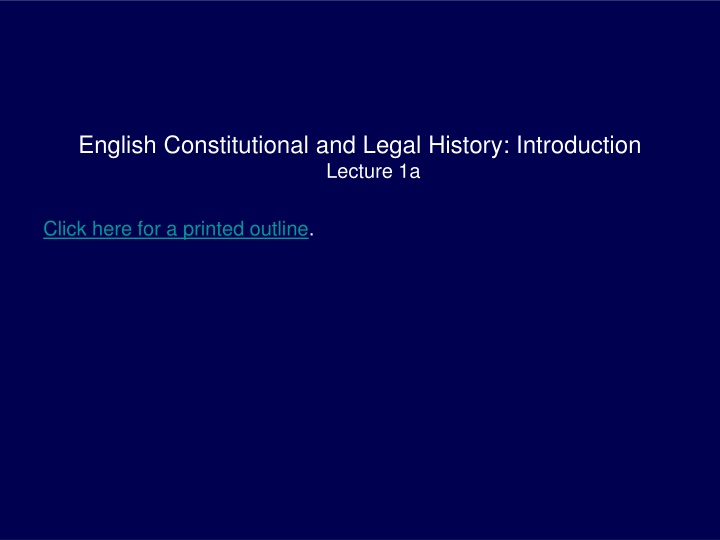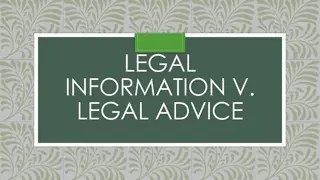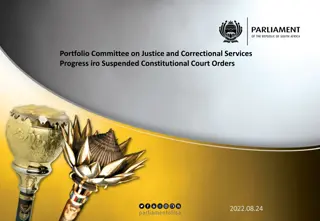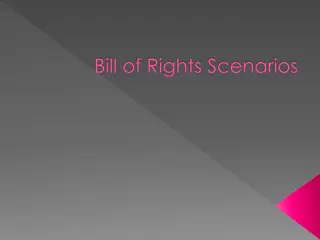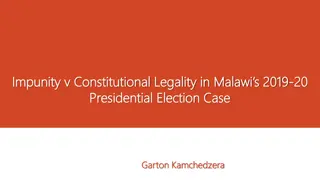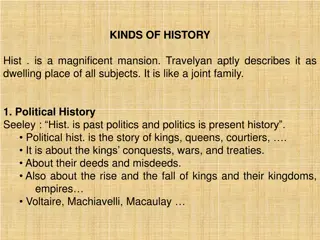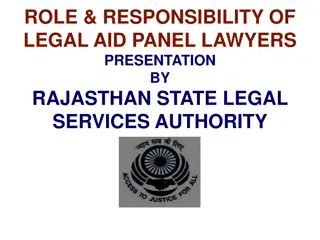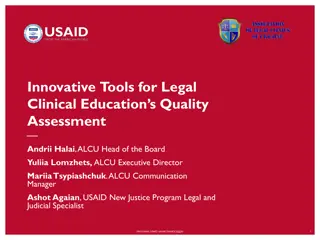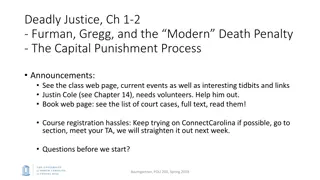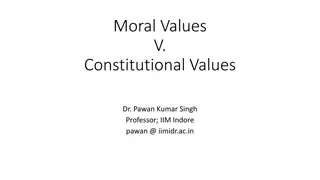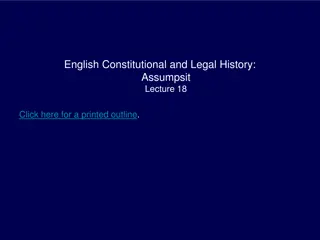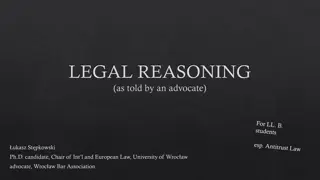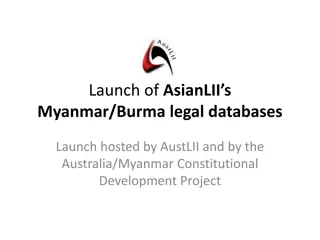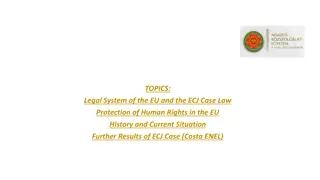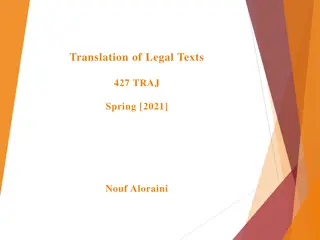English Constitutional and Legal History Overview
This course delves into the constitutional and legal history of England from the Anglo-Saxon invasions to the end of Queen Anne's reign. It explores the intricate connection between legal doctrines, institutions, society, and government structures, providing a comprehensive understanding of how they shaped English history. Through a synthesis of diverse histories, the course aims to uncover the interplay of ideas, institutions, and society throughout different historical periods, challenging anachronistic views and delving into the complexities of English constitutional development.
Download Presentation

Please find below an Image/Link to download the presentation.
The content on the website is provided AS IS for your information and personal use only. It may not be sold, licensed, or shared on other websites without obtaining consent from the author.If you encounter any issues during the download, it is possible that the publisher has removed the file from their server.
You are allowed to download the files provided on this website for personal or commercial use, subject to the condition that they are used lawfully. All files are the property of their respective owners.
The content on the website is provided AS IS for your information and personal use only. It may not be sold, licensed, or shared on other websites without obtaining consent from the author.
E N D
Presentation Transcript
English Constitutional and Legal History: Introduction Lecture 1a Click here for a printed outline.
What is this course about? The constitutional and legal history of England from the Anglo-Saxon invasions (c. 450) to the end of the reign of Queen Elizabeth (d. 1603) (for the undergraduates) or to that of Queen Anne (d. 1714) (for the law and graduate students). Common core of Monday and Wednesday classes, with a separate section meeting (tentatively scheduled for Fridays) for the undergraduates. Is this two courses or one? It s one: a common core of documents in the multilithed materials and all the readings are the same.
What is this course about? Legal. The legal is not just for the law students and constitutional just for the FAS students. If legal history were simply the study of the origins of modern legal doctrines and institutions, then it might be an appropriate course for the Law School and not for the FAS, but that s not what legal history is, or at least not what it ought to be. Any legal system worthy of the name is deeply embedded in the society and government that surrounds it. Legal doctrines and institutions may have a semi-autonomous existence, but that autonomy is far more likely to be in the minds of the lawyers than in reality. It is the privilege of the historian to see what the links are between the legal system and the wider social and governmental structures.
Pretend that medieval England had a constitution in the modern sense? The danger of anachronism and the mistakes of William Stubbs. Pretend that medieval England had a constitution in the modern sense? The danger of anachronism and the mistakes of William Stub Pretend that medieval England had a constitution in the modern sense? The danger of anachronism and the mistakes of William Stub What is this course about? Constitutional . Constitution in the modern sense is an anachronism for most of the period we will be studying. How do we deal with this fact? Pretend that medieval England had a constitution in the modern sense? The danger of anachronism and the mistakes of William Stubbs. The witenagemot of the Anglo-Saxons is not the origin of Parliament. Break up constitutional history into its constituent elements? (i) political history (ii) history of political theory (iii) administrative history (iv) social history (v) the history of legal institutions or ideas. Try to recover the vision of the great English constitutional historians (including Stubbs) had: A synthesis of three quite diverse histories: (i) legal, moral and political ideas, (ii) governmental and political institutions, (iii) social structure and social conflicts.
The interrelationship of Ideas, Institutions, and Society Ideas Institutions Society Society Ideas Institutions
The interrelationship of Ideas, Institutions, and Society (cont d) Examples of change at each level: In the Black Death of 1348 between a third and a half of the English population died. Henry II (1154 1189) made a number of changes in English institutions. About 50 years before Henry II Irnerius began a revival of the study of Roman law and Gratian began a revival of the study canon law.
A theme for the course? No one theme for the course, but rather a starting point and an ending point: Hengist and Horsa on the Isle of Thanet around 450 A.D., to Elizabeth I (d. 1603) or Queen Anne (d. 1714). One can start on a general theme for the course by focusing on the difference between legal and constitutional history. For our early periods, at least, the legal is but a phase of the broader picture. By the end it has become so specialized that one can think of legal and constitutional history as different. The story can be fit into either liberal or Marxist views of history, but it is more specific: the development of something called the common law.
Periodization The Age of Tort, 600 1150, Anglo-Saxon and Norman England. In this period we will see notions of kingship and lordship emerging out of the bedrock of a kin-based Germanic society, England united under one king, and in the king coming to be associated with the redress of legal wrongs, the tort referred to in the catch-phrase. The Age of Property, (1000?, 1066?) 1150 1300, Norman and Angevin England. In this period we will see a foreign conqueror developing a military system based on land- tenure, and his successors developing central royal institutions, which ultimately come to destabilize and transform the system that the conqueror had installed. Tabular outline of the periodization.
Periodization (contd) The Age of Trespass, (1250) 1300 1500 (1602), Plantagenet, Lancastrian, Yorkist and early Tudor England. In this period, we will see the emergence of Parliament as an important legal institution, and the central royal courts coming to take over the personal actions, what today we call tort and contract. The Age of Equity, (1375) 1500 1700, Lancastrian, Yorkist, Tudor and Stuart England. In this period, we will see social turmoil threatening to dismember the medieval system of law and institutions and how a new set of institutions modified the law but allowed for the preservation of a continuity with the past that was unusual for its period. Tabular outline of the periodization.
Remarks on the periodization The tag phrases that describe the periods, tort, property, trespass, equity are legal terms. The focus on particular substantive legal topics in each period involves some chronological distortions. The political developments in the table are largely identified with dynasties of English kings, but the dynasties give us a series of breaks that don t quite fit. There is an implied developmental theme here, one of increasing royal power tied to increasing sophistication of the law applied in the central royal courts. But the law and the lawyers have a force of their own; the law adapts to changes but retains a continuity with the past. I think the theme is correct but I also worry about it. The reason that I worry about it is, in a curious way, the topic of the next recorded lecture, the one on the legacy of Roman law.
Method of proceeding Our story will proceed by two methods: quite traditional lectures, and examination of documents. The first needs no explanation except to say that I plan to record as many of them as I can so that we can spend time in class discussing the contents of the lectures rather than listening to me wandering on. As for the second, the great English constitutional historians of the past pioneered the notion of learning from documentary material: (a) because you should learn to make your own generalizations, (b) because of its value for habits of thought (checking the evidence), and (c) because this is a revisionist period, and hence we should go back to the sources. Always read the documents first. You should quit with the secondary reading assignments when you think you know where it s going, but puzzle over the documents. The next two recorded lectures will illustrate the method.
Why take this course (particularly undergraduates)? I s a fascinating story. that deals with timeless problems. It s a traditional course for those thinking about law school. But not only for such people. Harvard is a great place to do it. Harvard owns some great examples of the original documents. We have the tech that allows us to see many more. Harvard owns some great examples of the original documents. We have the tech that allows us to see many more.
